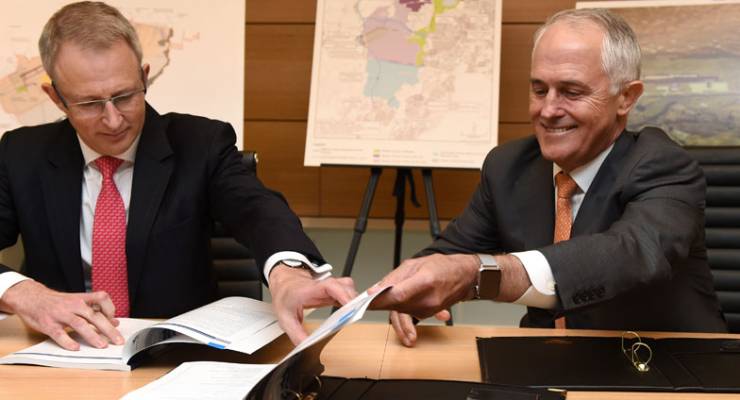
Prime Minister Malcolm Turnbull (right), and Federal Urban Infrastructure Minister Paul Fletcher sign copies of the airport plan
Badgerys Creek airport has long been a difficult issue: it has proven so intractable that 70 years of trying hasn’t yielded any laid tarmac. But now, the deal seems closed, with final government approval of the Environmental Impact Statement (EIS) process given by PM Malcolm Turnbull on December 12. Yet critical attention to this issue is still important, because it is, if nothing else, a case study of the failings of government-run EIS processes.
While much media attention has been given to the EIS’ modelling of aircraft noise, there has been no scrutiny of its other crucial remit: to assess whether the airport is actually needed. There is reason to believe that the information the EIS draws on is worryingly incomplete, or worse, that it has turned a blind eye to any modelling that contests the assumption that a second airport is needed.
The bottom line is that a second airport is only needed if the existing one cannot cope with passenger and freight demand into the foreseeable future. There are three reasons to think that maybe Sydney Airport can cope after all.
The key forecast figures leave room for doubt
For its demand forecasting, the EIS relied on the findings of the Joint Study on Aviation Capacity in the Sydney Region, completed in 2012. That study found that by 2027, air movements at Sydney Airport would be at capacity. That finding overwhelmingly supports immediate commencement of work on Badgerys Creek airport.
Yet one hybrid forecast deep in the bowels of the joint study documentation showed that Sydney Airport would only reach movement capacity after 2060. This forecast incorporated figures from the 2009 Sydney Airport Master Plan detailing future passenger-carrying capacity of planes and high flexibility in moving peak-hour flights. This buried forecast illustrates the EIS’ hidden uncertainty as to when an airport will be needed.
The master plan is prepared by Sydney Airport Corporation every four or five years and projects demand over a 20-year horizon. The latest of these, the Sydney Airport Master Plan 2033, was ticked off by former infrastructure minister Warren Truss in February 2014.
So what was the master plan forecast for 2033?
In stark contrast to the EIS, the newest master plan found that even under the constraints of current regulations, Sydney Airport can meet demand in the year 2033 and beyond. It found that if regulations were relaxed, demand would be met even more comfortably. In a modelled busy day in 2033, Sydney Airport is at full capacity for only a few hours.
Consequently the master plan and EIS have starkly different vision for the future. The master plan prioritises amending regulations and optimising the use of the existing Sydney Basin airports, including making some civil use of Richmond airbase. The EIS was disinterested in such a vision and totally ignored Master Plan 2033.
High-speed rail could help and may actually happen
The EIS dismisses the relevance of high-speed rail (HSR), explaining that the joint study found it wouldn’t be able to address many of the key drivers of growth in aviation demand. The joint study did provide the caveat that this would be further examined in the upcoming federal government’s HSR Phase 2 Report. The EIS authors never bothered reading it.
So what were the findings of that HSR Phase 2 Report, released in April 2013?
In complete contrast to the joint study, the HSR Phase 2 Report forecast that if HSR was in place in 2035, all routes in Sydney to — or from — Brisbane, Canberra and Melbourne would have more HSR travellers than air travellers. Forty per cent of all of Sydney Airport flights are to and from those cities. With HSR taking a big bite out of that 40%, that would allow Sydney Airport to accommodate growth in other routes.
Could fast rail be in place by the mid-2030s?
The HSR Phase 2 Report stated the Sydney-Canberra-Melbourne part of east-coast HSR could reasonably be built by 2035-2040. Funding — a fair bit of it, too — would be required. It could come from government. Consolidated Land and Rail Australia has put in a first private bid and Turnbull has suggested it could be funded from HSR-induced property value rises in rural towns along the HSR route. So there is hope in making HSR a reality that alleviates the need for a second Sydney Airport, but it needs more investigative work.
The right way forward
The Environmental Impact Statement process run by the Department of Infrastructure and Regional Development has been grossly inadequate. Two crucial reports, the Sydney Airport Master Plan 2033 and High Speed Rail Study Phase 2 Report, were ignored, which meant that the EIS failed to apply the necessary rigour in determining the need for the airport.
This failure mandates a properly independent analysis into how and when to stage Badgerys Creek airport, taking into consideration the twin impacts of, 1) demand — which needs to be more precisely determined — for high-speed rail, and 2) optimisation of existing Sydney Basin airports. Such an analysis must be undertaken by a body trusted to be objective and that has the necessary skills. The Productivity Commission seems an obvious choice.







I think there has already been decades to assess the situation.
HSR has already been assessed.
Now when do we see action?
Air travel is the least easily decarbonised transport mode, except thru substitution. Was this risk assessed, particularly wrt the HST alternative?
It will be fun watching Customs & AFP, aka BruderFarce having a turf fight for office space and hegemony.
There are only two words for Sydney Airport: International embarrassment. Want proof? Just travel. Lesson? Don’t privatise essential infrastructure. Moral? Perhaps the national interest includes an aviation capability. Actually, come to think of it, how couldn’t it???